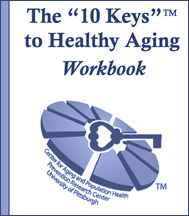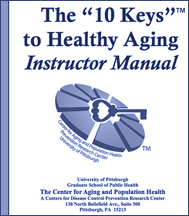

 The Workbook will assist you in learning about the "10 Keys"TM to Healthy Aging. You will learn to identify your risk factors and begin "Action Steps" for change.
The Workbook will assist you in learning about the "10 Keys"TM to Healthy Aging. You will learn to identify your risk factors and begin "Action Steps" for change.
- Have paper and a pencil ready.
- The included homework assignments and activities are highly recommended.
- You can take as long as you like to complete the program. The time can be spread out, such as one Key a day, or it can be taken all at once. This is up to you!
Workbook Materials *
Addendum materials
* Updates have been made in the Participant Workbook as a result of new blood pressure recommendations made by the American College of Cardiology and American Heart Association. Replace these sections with the new documents included with the addendum materials and apply the new guidelines effective immediately.
 The Instructor Manual will assist you if you plan to promote the "10 Keys"TM to Healthy Aging Program in your community or work.
The Instructor Manual will assist you if you plan to promote the "10 Keys"TM to Healthy Aging Program in your community or work.
IMPORTANT
Completion of the "10 Keys"TM to Healthy Aging Online Educational Program is required before you deliver the "10 Keys"TM program in your community or workplace. The Instructor Manual provides essential guidance beyond the Online Educational Program to enhance your experience.
Instructor Manual *
Addendum materials
* Updates have been made in the Instructor Manual as a result of new blood pressure recommendations made by the American College of Cardiology and American Heart Association. Replace these sections with the new documents included with the addendum materials and apply the new guidelines effective immediately.
Medical Disclaimer
All material in the "10 Keys"TM to Healthy Aging Workbook and the Instructor Manual is provided for your information only and may not be construed as personal medical advice or instruction. No action or inaction should be taken based solely on the contents of this information. Readers should consult appropriate healthcare professionals on any matter relating to their health and well-being. The Workbook and Instructor Manual are not substitutes for medical services. Do not act or rely upon this information without seeking the advice of your physician.By using the "10 Keys"TM to Healthy Aging Workbook and the Instructor Manual, you agree to hold the Center for Aging and Population Health - Prevention Research Center, and all of its affiliated organizations, harmless and waive liability for any information provided, and any decisions you may make related to this information or its use.
Note to those who will use The "10 Keys"TM to Healthy Aging Workbook and/or The "10 Keys"TM to Healthy Aging Instructor Manual:
The "10 Keys"TM to Healthy Aging guidelines used throughout this book were developed from evidence-based research in individuals age 65 years and older. With some modifications, the guidelines can be adapted to be proactive to meet the needs of adults age 50 years and older.
The "10 Keys"TM to Healthy Aging Workbook contains the most up-to-date prevention guidelines available at the time of publication. We use recommendations with a strong scientific evidence base from leading groups such as the Centers for Disease Control, United States Preventive Services Task Force, and Institute of Medicine to inform our content.
Since science is always changing, we do a complete review of the "10 Keys"TM content on a biannual basis, which includes a detailed review by leading experts in each of the "Key" content areas. Updates with late-breaking prevention news can be found on the CAPH Prevention Research Center website:
www.caph.pitt.edu
This version of the Workbook was finalized on March 21, 2016.
The "10 Keys"TM to Healthy Aging guidelines used throughout this book were developed from evidence-based research in individuals age 65 years and older. With some modifications, the guidelines can be adapted to be proactive to meet the needs of adults age 50 years and older.
The "10 Keys"TM to Healthy Aging Workbook contains the most up-to-date prevention guidelines available at the time of publication. We use recommendations with a strong scientific evidence base from leading groups such as the Centers for Disease Control, United States Preventive Services Task Force, and Institute of Medicine to inform our content.
Since science is always changing, we do a complete review of the "10 Keys"TM content on a biannual basis, which includes a detailed review by leading experts in each of the "Key" content areas. Updates with late-breaking prevention news can be found on the CAPH Prevention Research Center website:
www.caph.pitt.edu
This version of the Workbook was finalized on March 21, 2016.
Copyright © 2018 Center for Aging and Population Health, A Centers for Disease Control Prevention Research Center, Graduate School of Public Health, University of Pittsburgh, Pittsburgh, Pennsylvania
The University of Pittsburgh's Center for Aging and Population Health is a member of the Prevention Research Centers Program, supported by the Centers for Disease Control and Prevention cooperative agreement number U48DP01918-02 and 1 U48DP005001-01.
Printing of this publication was supported by the Centers for Disease Control and Prevention cooperative agreement number U48DP019.
